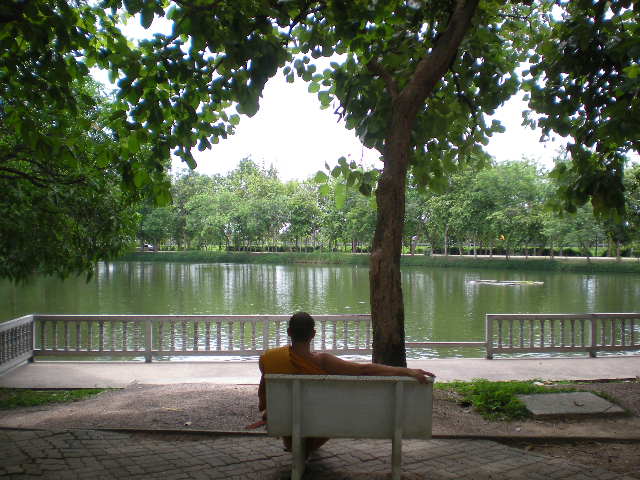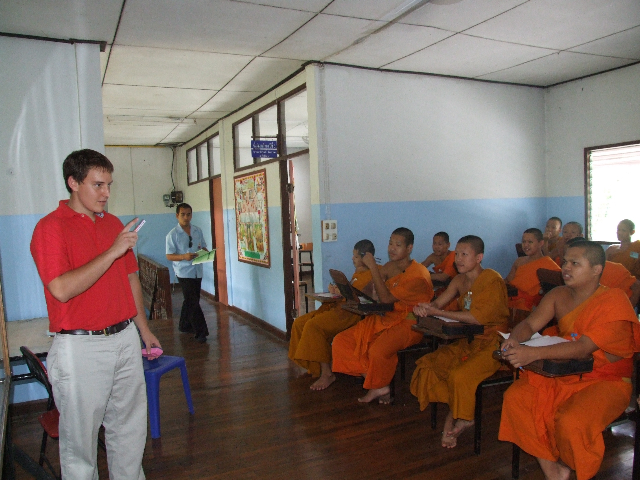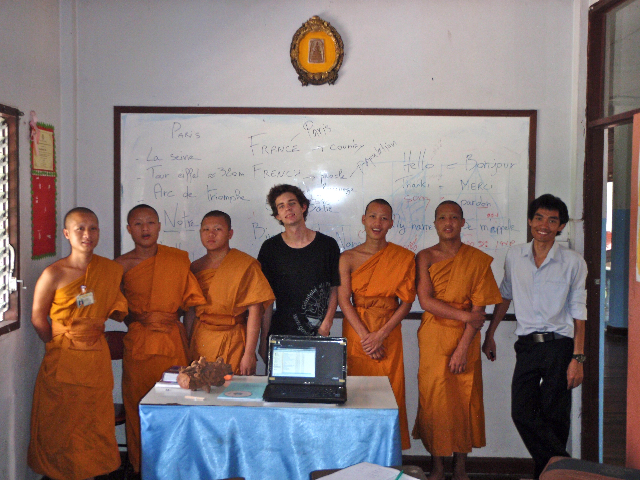In the context of Buddhist travel in Thailand, currently there are two categories of offerings that surface among the many programs available for international travelers: Buddhist practice and cultural exchange. Programs that focus on meditation, the Buddhist practice par excellence, often downplay any cultural experience that might be involved. In these programs, serious practice involves many hours of personal meditation with little chance to chant, attend rituals, or ask questions about the Buddhist tradition with the exception of those relating to meditation. In contrast, the second type of program, involving cultural exchange, is designed to do the opposite–to expose the international visitor to the ‘culture’ of the Buddhist tradition. One emerging way to become a part of such a program is volunteering as an English teacher for the monks and novices of a large temple.
Photo: Wat Luang Por Sot
These cultural experiences are considered educational opportunities, where one can learn about one of the world’s religions as part of the larger pluralist effort of mutual understanding. Phra Khru Baitika (Dr. Barton Yanathiro or Phra Bart) is the international outreach coordinator for Wat Luang Por Sot’s International Outreach Program located in Rajburi province. The focus of the temple is mainly on Thai laity and monastics but Phra Bart heads the foreign programs. Currently there are two types of international visitors coming to Wat Luang Por Sot: the meditators and the teachers. The teachers have a chance to meditate as well but not as often because they must prepare for and teach classes in the morning and evening. The teachers are to use Buddhist materials in order to prepare Thai monks to teach about Buddhism in English. In this way, the program advertizes that the international visitors have an opportunity to experience Thai and Buddhist culture.
Phra Bart’s first meditation student was involved with a volunteer travel website. Eventually, after contact with this student, Phra Bart created the idea that foreigners could come to teach the monks of Wat Luang Por Sot as volunteer service. This idea blossomed into the Buddhist Immersion EFL program run through the Global Service Corps website. This volunteer abroad service advertises that its mission is to incorporate service to local communities with cultural immersion for its volunteers. For this Buddhist Immersion program, they hope to provide an experience for those looking to teach as well as experience life in a Buddhist monastery and the traditions of Thai society such as chanting, participating in alms giving, and other ritual celebrations. In addition to teaching English, volunteers can participate in up to three one-hour guided meditation sessions per day. As well the orientation weekend for volunteers in Bangkok includes visiting famous Thai temples and lessons in Thai food and eating, Thai customs and language. Volunteers who stay for a month or longer have the opportunity to visit a local village, with the stated purpose being to experience the life of lay Buddhists in their community.
There is some flexibility in regard to the level of immersion one can experience. A volunteer can live in the temple compound or in a residence across the road, and one can choose to observe the more strict 8 precepts where there is no eating after noon; or 5 precepts where one is able to eat 3 meals a day. In the first few months of the volunteer program, Phra Bart used to have a ceremony giving the 8 precepts to each participant. This was until some of the volunteers told him they were not Buddhist and did not want to keep these rules, thus volunteers now have the choice to keep 5 or 8 precepts. This flexibility demonstrates the cultural nature of the experience, rather than a strict focus on Buddhist meditation.
The literature for this Buddhist Immersion EFL program emphasizes the cultural experiences the volunteers will engage in by living at the temple and interacting with monks and Thai lay visitors. Thus Buddhist practice is here advertised as a part of a cultural immersion experience that is packaged with teaching English, visiting local village temples, eating local food, and participating in morning and evening chanting.
Photo: Wat Doi Saket
The other example of an English teaching volunteer program at a temple is the recently designed proram at Wat Doi Saket, Chiang Mai. In comparison with the volunteer program at Wat Luang Por Sot, Wat Doi Saket’s program is much newer and doesn’t have as much of a meditation focus. This program started recently with the first volunteer completing a two-month stay. It is also not as large as Wat Luang Por Sot’s program as only two volunteers would be needed at one time. There are opportunities for volunteers to teach at local schools in the area as well as the novices at the wat.
English teaching programs at temples require a large number of novices in order for the temple and the foreign participant to benefit. Wat Doi Saket, with its large complex of buildings and school for novices, meets this requirement. But this is also a place of interest on its own with a stupa and relic, modern murals, and a mini-zoo and view further up the mountain beyond the temple.
Photo: Dave with Monks
David Poppe, program manager, brought me to Wat Doi Saket this October. He works for the Atma Seva non-profit organization and created this program as one of the organization’s volunteer journeys. He explained to me that the organization had an affiliation with Wat Doi Saket when they used to hold HIV/AIDS educational trainings here for children in government schools. After ten years of these weekend or Saturday seminars, Atma Seva and the senior monks at the wat had a meeting to decide if they should continue. The abbot asked for more English learning opportunities for his monks instead. Thus this volunteer program was created to bring English speakers into the wat for conversation lessons.
Photo: Volunteer with Monks
Unlike at Wat Luang Por Sot there is no decision about how many precepts to keep since the volunteers in this program are not asked to follow these rules. Before residing at the temple basic rules for living in this environment are explained: prohibition on drugs or alcohol on the premises, respect for the culture and religion, such as not to point one’s feet at the Buddha statue and no contact with the monks for females. Volunteers must sign a form that they are aware that any infraction means an automatic ejection from the program. Between the form and rules the program manager feels Wat Doi Saket is protected from any incidents that might occur.
The literature for this program emphasizes that through volunteering there are limitless opportunities to learn about Buddhism and meditation, if one chooses. At Wat Doi Saket there are a few monks who can speak some English and will answer any questions the volunteer has about the religion they see around them. But it is up to the individual to ask and seek out the opportunities. There is also a meditation teacher who teaches monks and, if a volunteer is interested they can have lessons with the teacher and then attend meditation retreats with monks.
Thus religion and Buddhist practice is not a formal part of this program but an added benefit. But the main appeal of both of these programs derives from the cultural exchange one is able to have while teaching the monks and experiencing life at the temple. In this age of modern religions, religion becomes something optional to experiment with or be curious about in a pluralistic manner, however, culture is for all to enjoy without having to clarify that this is an optional component. This is the opposite idea of many spiritual seekers in Thailand who often comment that it is the ‘core’ of the Buddhist religion that they want to experience, not the culture. For this group they want to remove, if possible, the cultural aspects and only practice the ‘heart’ of the teaching. But for volunteers coming to teach English it is culture that is the attraction and religious practice becomes an added, elective bonus.
 Facebook
Facebook  Twitter
Twitter  Soundcloud
Soundcloud  Youtube
Youtube  Rss
Rss 


